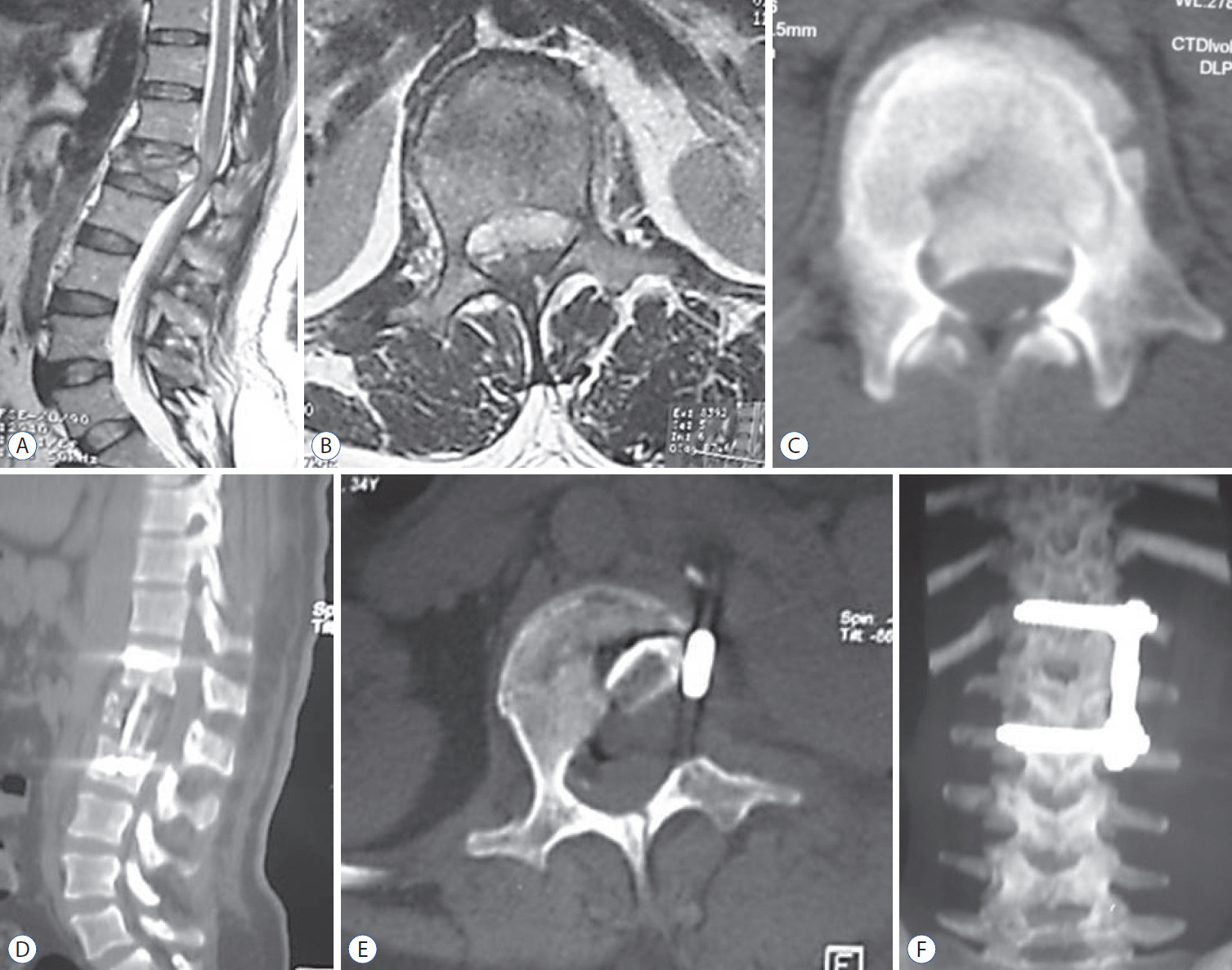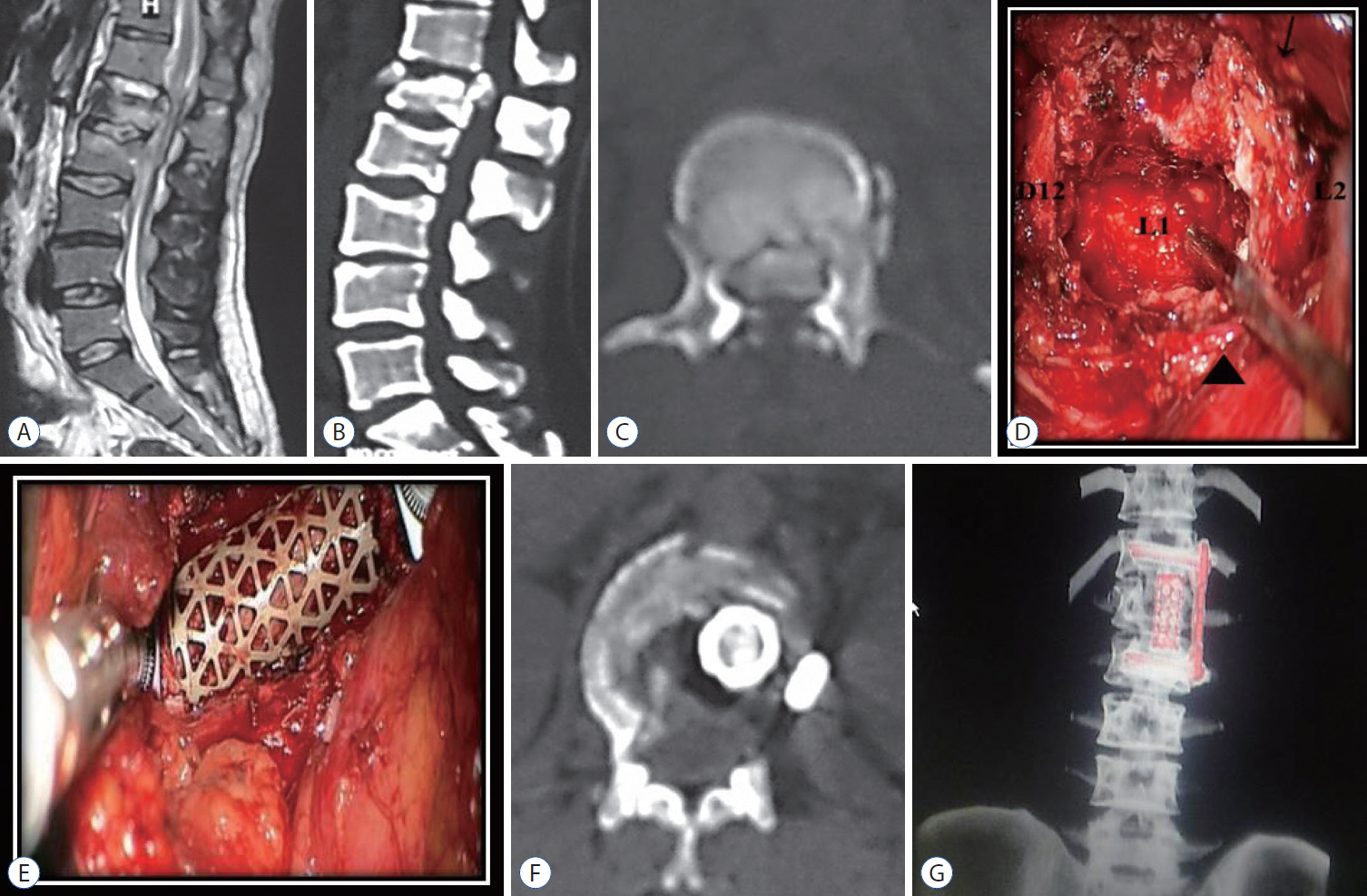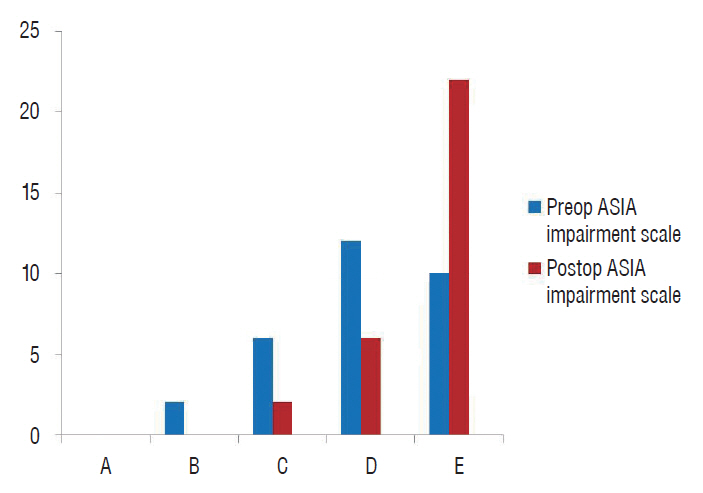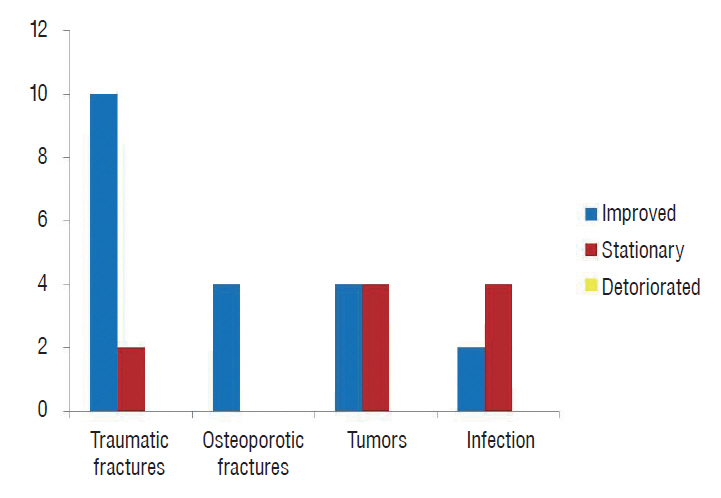J Korean Neurosurg Soc.
2019 Jan;62(1):61-70. 10.3340/jkns.2017.0271.
Retroperitoneal Extrapleural Approach for Corpectomy of the First Lumbar Vertebra : Technique and Outcome
- Affiliations
-
- 1Department of Neurosurgery, Faculty of Medicine, Alexandria University, Alexandria, Egypt. zidanihab@yahoo.fr
- KMID: 2434347
- DOI: http://doi.org/10.3340/jkns.2017.0271
Abstract
OBJECTIVE
Corpectomy of the first lumbar vertebra (L1) for the management of different L1 pathologies can be performed using either an anterior or posterior approach. The aim of this study was to evaluate the usefulness of a retroperitoneal extrapleural approach through the twelfth rib for performing L1 corpectomy.
METHODS
Thirty consecutive patients underwent L1 corpectomy between 2010 and 2016. The retroperitoneal extrapleural approach through the 12th rib was used in all cases to perform single-stage anterior L1 corpectomy, reconstruction and anterior instrumentation, except for in two recurrent cases in which posterior fixation was added. Visual analogue scale (VAS) was used for pain intensity measurement and ASIA impairment scale for neurological assessment. The mean follow-up period was 14.5 months.
RESULTS
The sample included 18 males and 12 females, and the mean age was 40.3 years. Twenty patients (67%) had sensory or motor deficits before the surgery. The pathologies encountered included traumatic fracture in 12 cases, osteoporotic fracture in four cases, tumor in eight cases and spinal infection in the remaining six cases. The surgeries were performed from the left side, except in two cases. There was significant improvement of back pain and radicular pain as recorded by VAS. One patient exhibited postoperative neurological deterioration due to bone graft dislodgement. All patients with deficits at least partially improved after the surgery. During the follow-up, no hardware failures or losses of correction were detected.
CONCLUSION
The retroperitoneal extrapleural approach through the 12th rib is a feasible approach for L1 corpectomy that can combine adequate decompression of the dural sac with effective biomechanical restoration of the compromised anterior load-bearing column. It is associated with less pulmonary complication, no need for chest tube, no abdominal distention and rapid recovery compared with other approaches.
Keyword
MeSH Terms
Figure
Reference
-
References
1. Anand N, Regan JJ. Video-assisted thoracoscopic surgery for thoracic disc disease: classification and outcome study of 100 consecutive cases with a 2-year minimum follow-up period. Spine (Phila Pa 1976). 27:871–879. 2002.2. Anderson TM, Mansour KA, Miller JI Jr. Thoracic approaches to anterior spinal operations: anterior thoracic approaches. Ann Thorac Surg. 55:1447–1451. 1993.
Article3. Baker JK, Reardon PR, Reardon MJ, Heggeness MH. Vascular injury in anterior lumbar surgery. Spine (Phila Pa 1976). 18:2227–2230. 1993.
Article4. Beisse R. Endoscopic surgery on the thoracolumbar junction of the spine. Eur Spine J. 19 Suppl 1:S52–S65. 2010.
Article5. Bradford DS, McBride GG. Surgical management of thoracolumbar spine fractures with incomplete neurologic deficits. Clin Orthop Relat Res. (218):201–216. 1987.
Article6. Chou D, Wang VY, Gupta N. Transpedicular corpectomy with posterior expandable cage placement for L1 burst fracture. J Clin Neurosci. 16:1069–1072. 2009.
Article7. Cunningham BW, Kotani Y, McNulty PS, Cappuccino A, Kanayama M, Fedder IL, et al. Video-assisted thoracoscopic surgery versus open thoracotomy for anterior thoracic spinal fusion. a comparative radiographic, biomechanical, and histologic analysis in a sheep model. Spine (Phila Pa 1976). 23:1333–1340. 1998.
Article8. Escobar E, Transfeldt E, Garvey T, Ogilvie J, Graber J, Schultz L. Video-assisted versus open anterior lumbar spine fusion surgery: a comparison of four techniques and complications in 135 patients. Spine (Phila Pa 1976). 28:729–732. 2003.9. Faciszewski T, Winter RB, Lonstein JE, Denis F, Johnson L. The surgical and medical perioperative complications of anterior spinal fusion surgery in the thoracic and lumbar spine in adults. a review of 1223 procedures. Spine (Phila Pa 1976). 20:1592–1599. 1995.
Article10. Fourney DR, Gokaslan ZL. Anterior approaches for thoracolumbar metastatic spine tumors. Neurosurg Clin N Am. 15:443–451. 2004.
Article11. Gandhoke GS, Tempel ZJ, Bonfield CM, Madhok R, Okonkwo DO, Kanter AS. Technical nuances of the minimally invasive extreme lateral approach to treat thoracolumbar burst fractures. Eur Spine J 24 Suppl. 3:353–360. 2015.
Article12. Gumbs AA, Bloom ND, Bitan FD, Hanan SH. Open anterior approaches for lumbar spine procedures. Am J Surg. 194:98–102. 2007.
Article13. Hodgson AR, Yau AC. Anterior surgical approaches to the spinal column in Apley AG (ed): Recent Advances in Orthopedics. Williams & Wilkins: Baltimore;1964. p. 289–323.14. Ikard RW. Methods and complications of anterior exposure of the thoracic and lumbar spine. Arch Surg. 141:1025–1034. 2006.
Article15. Jain AK, Dhammi IK, Jain S, Kumar J. Simultaneously anterior decompression and posterior instrumentation by extrapleural retroperitoneal approach in thoracolumbar lesions. Indian J Orthop. 44:409–416. 2010.
Article16. Kim DH, Jaikumar S, Kam AC. Minimally invasive spine instrumentation. Neurosurgery. 51(5 Suppl):S15–S25. 2002.
Article17. Kim M, Nolan P, Finkelstein JA. Evaluation of 11th rib extrapleural-retroperitoneal approach to the thoracolumbar junction. Technical note. J Neurosurg. 93(1 Suppl):168–174. 2000.
Article18. Knoeller SM, Huwert O, Wolter T. Single stage corpectomy and instrumentation in the treatment of pathological fractures in the lumbar spine. Int Orthop. 36:111–117. 2012.
Article19. Knop C, Lange U, Bastian L, Blauth M. Three-dimensional motion analysis with Synex. Comparative biomechanical test series with a new vertebral body replacement for the thoracolumbar spine. Eur Spine J. 9:472–485. 2000.20. Korkusuz F, Islam C, Korkusuz Z. Prevention of postoperative late kyphosis in Pott's disease by anterior decompression and intervertebral grafting. World J Surg. 21:524–528. 1997.
Article21. Korkusuz Z, Binnet MS, Isiklar ZU. Pott's disease and extrapleural anterior decompression. Results of 108 consecutive cases. Arch Orthop Trauma Surg. 108:349–352. 1989.
Article22. Kozak JA, O'Brien JP. Simultaneous combined anterior and posterior fusion. An independent analysis of a treatment for the disabled low-back pain patient. Spine (Phila Pa 1976). 15:322–328. 1990.
Article23. Lin RM, Huang KY, Lai KA. Mini-open anterior spine surgery for anterior lumbar diseases. Eur Spine J. 17:691–697. 2008.
Article24. Litré CF, Duntze J, Benhima Y, Eap C, Malikov S, Pech-Gourg G, et al. Anterior minimally invasive extrapleural retroperitoneal approach to the thoraco-lumbar junction of the spine. Orthop Traumatol Surg Res. 99:94–98. 2013.
Article25. Lu DC, Lau D, Lee JG, Chou D. The transpedicular approach compared with the anterior approach: an analysis of 80 thoracolumbar corpectomies. J Neurosurg Spine. 12:583–591. 2010.
Article26. McAfee PC. Complications of anterior approaches to the thoracolumbar spine. Emphasis on Kaneda instrumentation. Clin Orthop Relat Res. 306:110–119. 1994.27. McAfee PC, Regan JR, Zdeblick T, Zuckerman J, Picetti GD 3rd, Heim S, et al. The incidence of complications in endoscopic anterior thoracolumbar spinal reconstructive surgery. A prospective multicenter study comprising the first 100 consecutive cases. Spine (Phila Pa 1976). 20:1624–1632. 1995.
Article28. McDonnell MF, Glassman SD, Dimar JR 2nd, Puno RM, Johnson JR. Perioperative complications of anterior procedures on the spine. J Bone Joint Surg Am. 78:839–847. 1996.
Article29. McDonough PW, Davis R, Tribus C, Zdeblick TA. The management of acute thoracolumbar burst fractures with anterior corpectomy and Z-plate fixation. Spine (Phila Pa 1976). 29:1901–1908. discussion 1909. 2004.
Article30. Orchowski J, Bridwell KH, Lenke LG. Neurological deficit from a purely vascular etiology after unilateral vessel ligation during anterior thoracolumbar fusion of the spine. Spine (Phila Pa 1976). 30:406–410. 2005.
Article31. Oskouian RJ Jr, Johnson JP. Vascular complications in anterior thoracolumbar spinal reconstruction. J Neurosurg. 96(1 Suppl):1–5. 2002.
Article32. Oskouian RJ Jr, Shaffrey CI, Whitehill R, Sansur CA, Pouratian N, Kanter AS, et al. Anterior stabilization of three-column thoracolumbar spinal trauma. J Neurosurg Spine. 5:18–25. 2006.
Article33. Pappou IP, Papadopoulos EC, Swanson AN, Mermer MJ, Fantini GA, Urban MK, et al. Pott disease in the thoracolumbar spine with marked kyphosis and progressive paraplegia necessitating posterior vertebral column resection and anterior reconstruction with a cage. Spine (Phila Pa 1976). 31:E123–E127. 2006.
Article34. Payer M, Sottas C. Mini-open anterior approach for corpectomy in the thoracolumbar spine. Surg Neurol. 69:25–31. discussion 31-32. 2008.
Article35. Penta M, Fraser RD. Anterior lumbar interbody fusion. a minimum 10-year follow-up. Spine (Phila Pa 1976). 22:2429–2434. 1997.36. Pflugmacher R, Schleicher P, Schaefer J, Scholz M, Ludwig K, Khodadadyan-Klostermann C, et al. Biomechanical comparison of expandable cages for vertebral body replacement in the thoracolumbar spine. Spine (Phila Pa 1976). 29:1413–1419. 2004.
Article37. Pham MH, Tuchman A, Chen TC, Acosta FL, Hsieh PC, Liu JC. Transpedicular corpectomy and cage placement in the treatment of traumatic lumbar burst fractures. Clin Spine Surg. 30:360–366. 2017.
Article38. Pradhan BB, Nassar JA, Delamarter RB, Wang JC. Single-level lumbar spine fusion: a comparison of anterior and posterior approaches. J Spinal Disord Tech. 15:355–361. 2002.
Article39. Quint U, Wilke HJ, Löer F, Claes LE. Functional sequelae of surgical decompression of the lumbar spine--a biomechanical study in vitro. Z Orthop Ihre Grenzgeb. 136:350–357. 1998.
Article40. Rauzzino MJ, Shaffrey CI, Nockels RP, Wiggins GC, Rock J, Wagner J. Anterior lumbar fusion with titanium threaded and mesh interbody cages. Neurosurg Focus. 7:e7. 1999.
Article41. Reinhold M, Knop C, Beisse R, Audigé L, Kandziora F, Pizanis A, et al. Operative treatment of 733 patients with acute thoracolumbar spinal injuries: comprehensive results from the second, prospective, internet-based multicenter study of the Spine Study Group of the German Association of Trauma Surgery. Eur Spine J. 19:1657–1676. 2010.
Article42. Saraph V, Lerch C, Walochnik N, Bach CM, Krismer M, Wimmer C. Comparison of conventional versus minimally invasive extraperitoneal approach for anterior lumbar interbody fusion. Eur Spine J. 13:425–431. 2004.
Article43. Sasso RC, Renkens K, Hanson D, Reilly T, McGuire RA Jr, Best NM. Unstable thoracolumbar burst fractures: anterior-only versus short-segment posterior fixation. J Spinal Disord Tech. 19:242–248. 2006.44. Scheufler KM. Technique and clinical results of minimally invasive reconstruction and stabilization of the thoracic and thoracolumbar spine with expandable cages and ventrolateral plate fixation. Neurosurgery. 61:798–808. discussion 808-809. 2007.
Article45. Schnake KJ, Stavridis SI, Kandziora F. Five-year clinical and radiological results of combined anteroposterior stabilization of thoracolumbar fractures. J Neurosurg Spine. 20:497–504. 2014.
Article46. Tribus C. Anterior approach to the thoracic and thoracolumbar spine. Semin Spine Surg. 21:49–54. 2009.
Article47. Wilke HJ, Kemmerich V, Claes LE, Arand M. Combined anteroposterior spinal fixation provides superior stabilisation to a single anterior or posterior procedure. J Bone Joint Surg Br. 83:609–617. 2001.
Article48. Winter RB, Lonstein JE, Denis F, Leonard AS, Garamella JJ. Paraplegia resulting from vessel ligation. Spine (Phila Pa 1976). 21:1232–1234. 1996.
Article49. Zdeblick TA, David SM. A prospective comparison of surgical approach for anterior L4-L5 fusion: laparoscopic versus mini anterior lumbar interbody fusion. Spine (Phila Pa 1976). 25:2682–2687. 2000.
- Full Text Links
- Actions
-
Cited
- CITED
-
- Close
- Share
- Similar articles
-
- Lumbar Corpectomy by Using Anterior Midline Route
- Clinical Analysis on the Anterior Approach for Tuberculous Spondylitis of Thoraco-Lumbar Junction
- Preventing Construct Subsidence Following Cervical Corpectomy: The Bump-stop Technique
- Traumatic Extrapleural Hematoma Mimicking Hemothorax
- Anatomy and Physiology of Lumbar Spine






